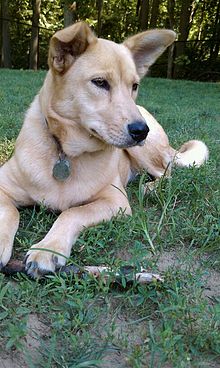Carolina Dog
 |
|||||||||||||||||
| Origin | USA | ||||||||||||||||
|---|---|---|---|---|---|---|---|---|---|---|---|---|---|---|---|---|---|
|
|||||||||||||||||
|
|||||||||||||||||
| Domestic dog (Canis lupus familiaris) | |||||||||||||||||
| Traits | |||
|---|---|---|---|
| Weight | 30–44 lb (14–20 kg) | ||
| Height | 17.75–19.75 in (45.1–50.2 cm) | ||
| Colour | Preferable: red ginger with pale buff markings over the shoulders, and pale white along the muzzle. | ||
| Classification / standards | |||
|---|---|---|---|
| UKC | Sighthound & Pariah | standard | |
The Carolina Dog was originally a landrace or naturally selected type of dog which was rediscovered living as a wild dog or free roaming dog by Dr. I. Lehr Brisbin, and originally documented in American dog breed publications in the 1920s. Carolina Dogs often live in isolated stretches of longleaf pines and cypress swamps in the Southeastern United States. A breed standard has been developed by the United Kennel Club that now specifies the appearance of these dogs. Carolina Dogs are a medium sized dog, that comes in varying shades of red ginger, buff, fawn, black, black and tan or piebald with or without small white markings on toes, chest, tail tip and muzzle. Frequently puppies have a melanistic mask that usually fades as the adult coat comes in.
One of the earliest publications to document Carolina Dogs was the article "Dogs of the American Aborigines" by Glover Morrill Allen, published in 1920 by the Museum of Comparative Zoology at Harvard College. Allen postulated that these "Larger or Common Indian Dogs" were descended from Asian primitive dogs: "The probability therefore is, that the Domestic Dog originated in Asia and was carried by primitive man both east and west into all parts of the inhabited world. That this migration began in late Pleistocene times seems highly probable." Allen cites late 19th century studies of skeletal remains of these dogs excavated from Indian mounds as well:
Cope (1893) was the first to describe the jaw of this dog from a specimen collected by Moore from a shell-mound on St. John's River, Florida. He was struck by the fact that the first lower premolar was missing and appeared not to have developed. The strong development of the entoconid of the carnassial, he also noticed. Moore, in the course of various explorations in Florida and Georgia discovered many remains of dogs, apparently of this type. In a large mound on Ossabaw Island, Georgia, he (1897) found several interments of human and dog-skeletons, the latter always buried sepa rately and entire, showing that the dogs had not been used as food. Other dog-skeletons of a similar sort were found by Moore (1899) in aboriginal mounds on the South Carolina coast.
...
Wikipedia
